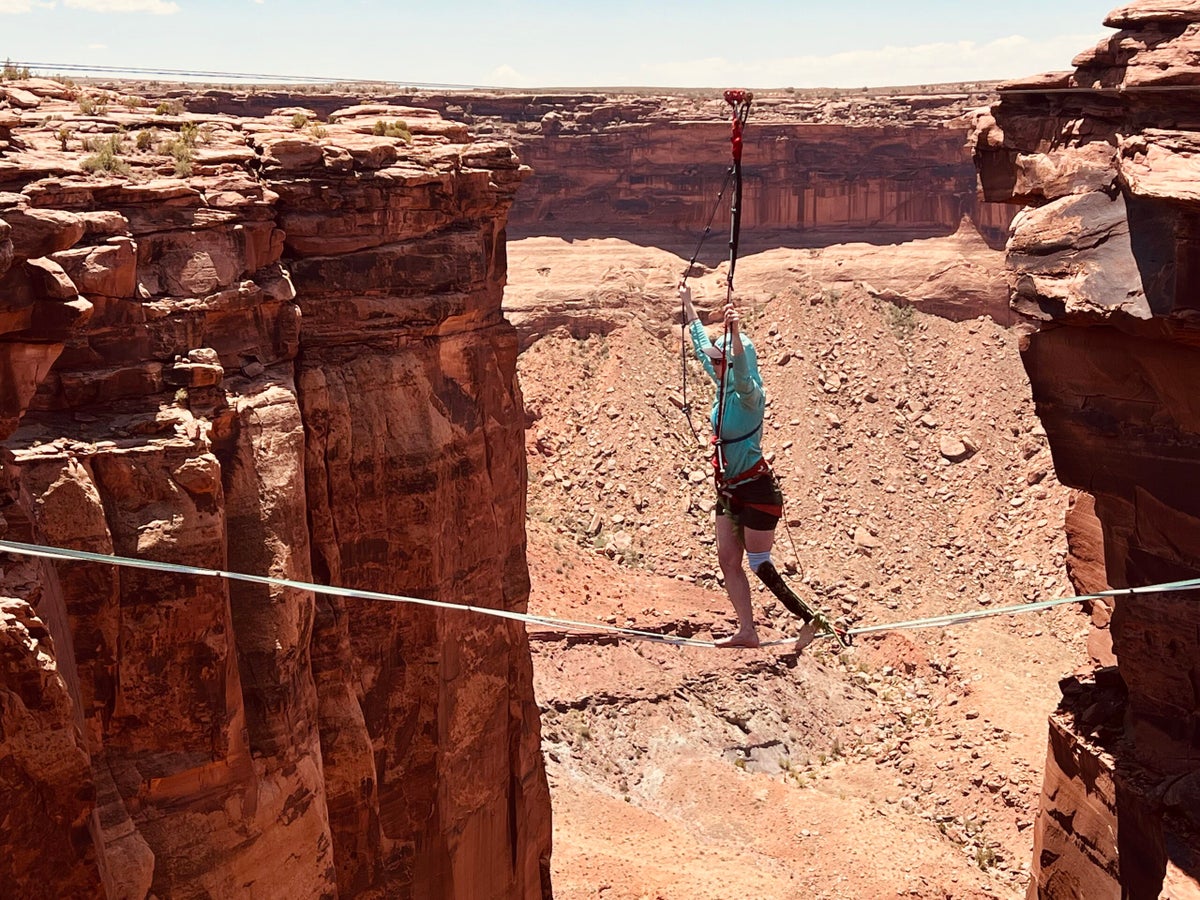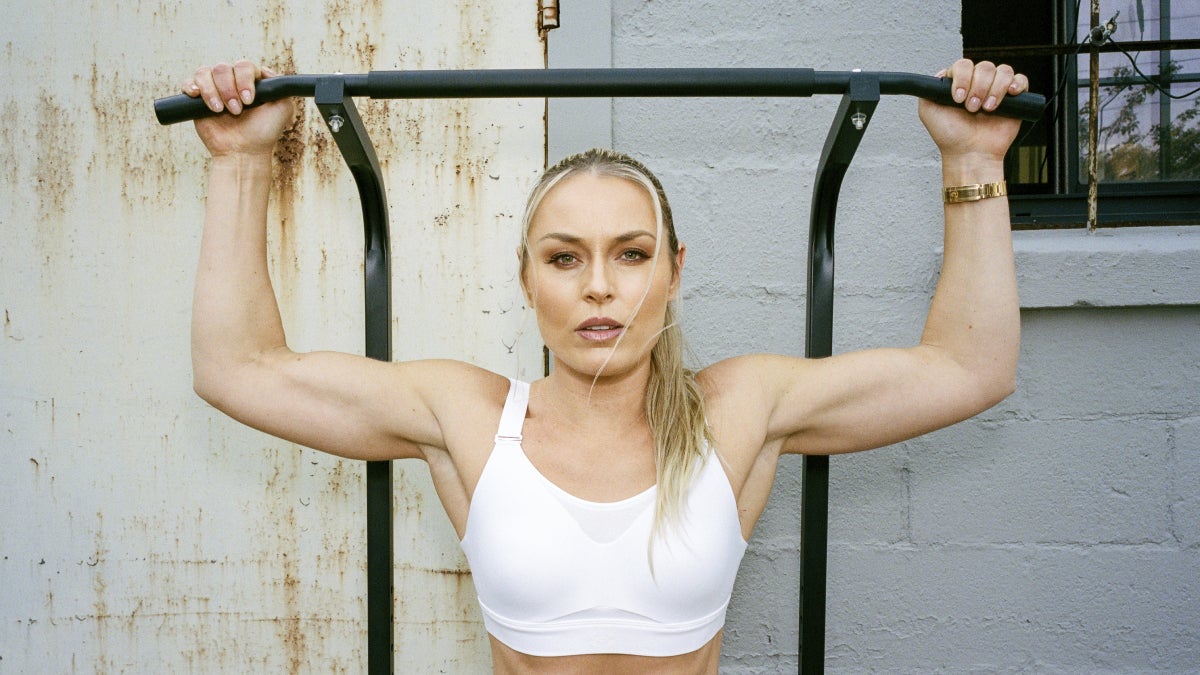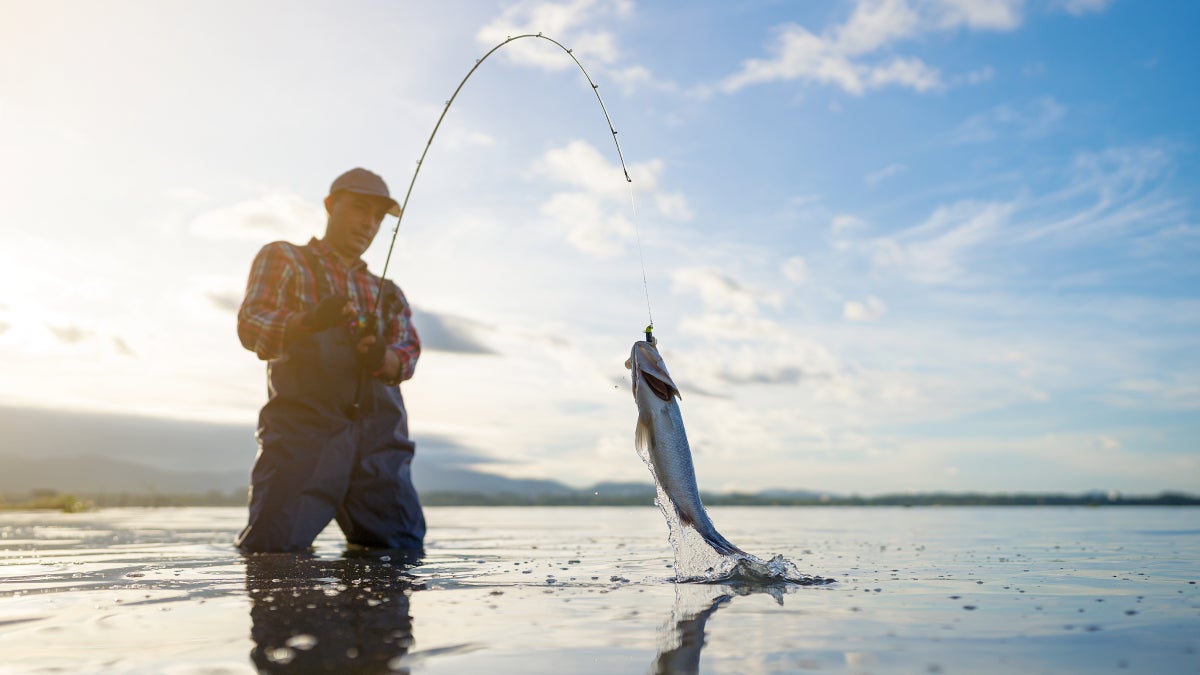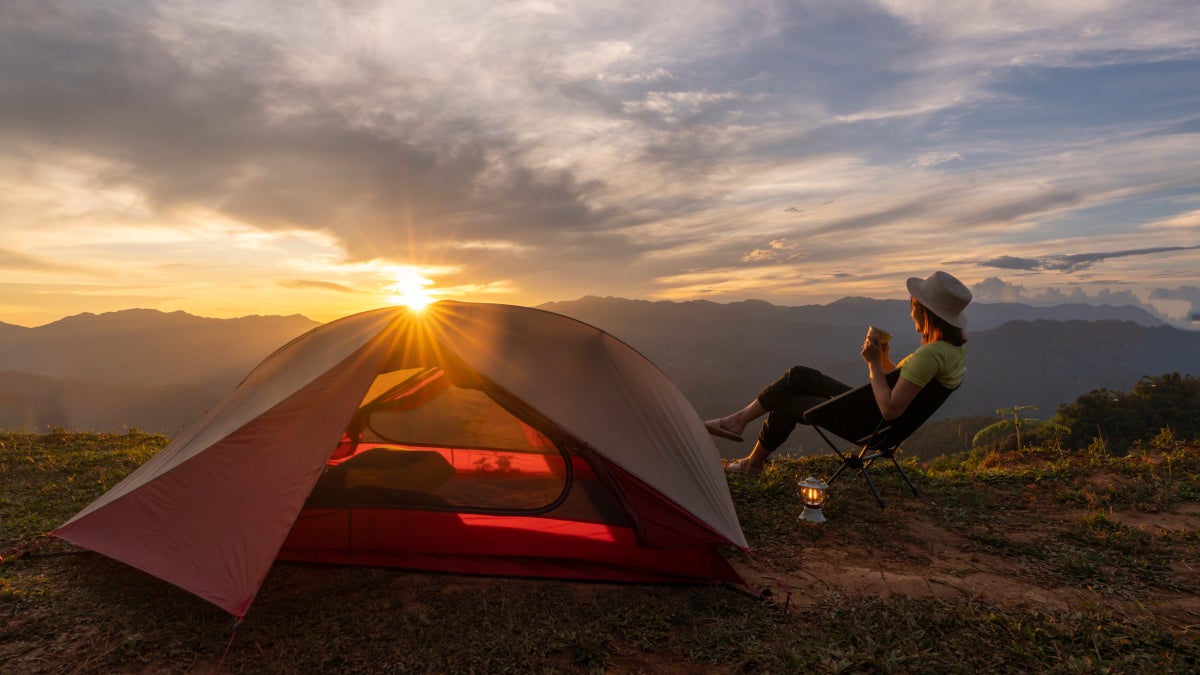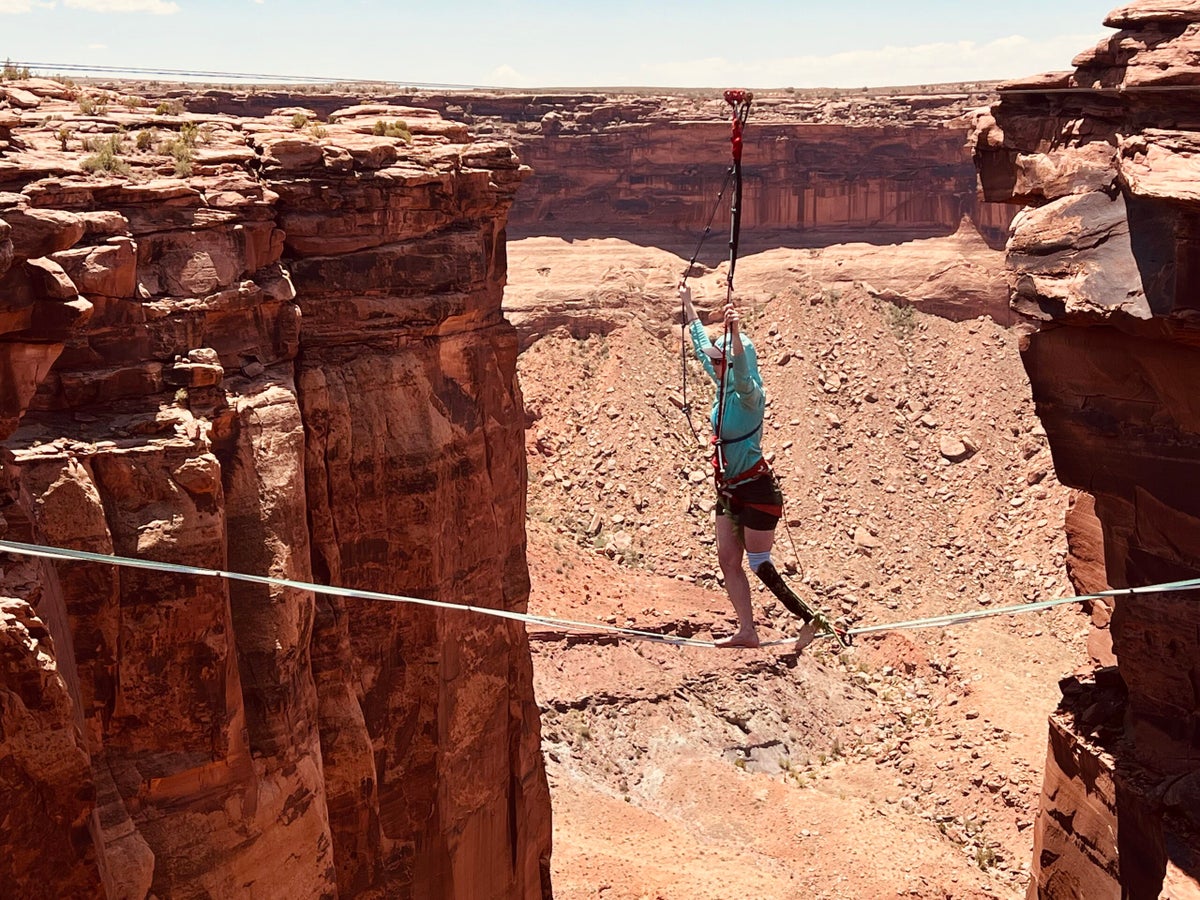
A few years ago, Faith Dickey went climbing in Utah’s Indian Creek with Jack Ryan Greener, who became quadriplegic in 2018 after a jiu-jitsu accident. While climbing, Dickey and Greener began wondering whether he might be able to highline—the act of walking a thin slackline strung high above the earth. Greener could take steps with trekking poles, but he had a hard time placing his feet with precision, partly due to involuntary muscle spasms. Dickey started by taking Greener to a park, where she set up a slackline right off the ground. With a person on either side offering significant support, he was able to do it.
“Dude, I think you can highline,” Dickey told Greener. As a 10-time world record holder in the female highline space, she knew what it would take for him to successfully walk the line. She is also the first person to “free solo” a highline—aka, do it without tethering herself to the line with a harness, meaning, in the event of a fall, she could plunge to the ground. Her talent for this niche sport has won her appearances in series on National Geographic, Discovery, and beyond.
When Dickey rigged the highline for Greener in March of 2023, he made several attempts, but kept falling. Each time, she’d have to go out on the line to help him back up. “It was pretty emotional,” she says, “because he wanted it so bad.” She could see that as a former surfer, he was used to feeling “super capable” in his body. But he couldn’t put the pieces together on the line that day.
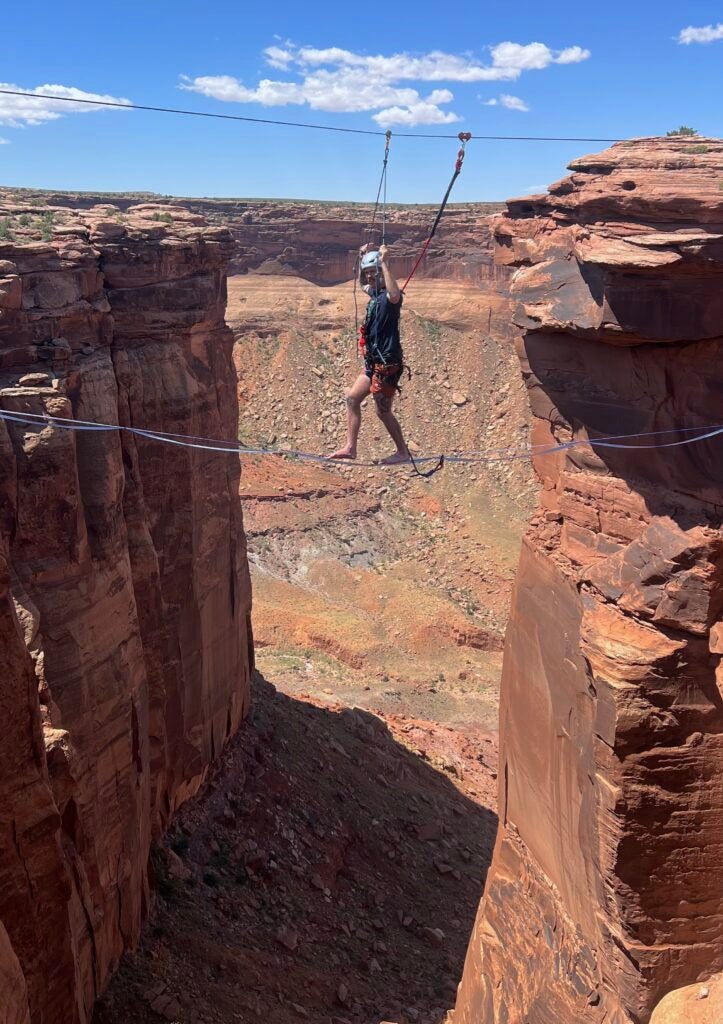
A few months later, Greener returned to Moab and decided to try highlining with Dickey again. About an hour west of Moab, she rigged a 65-foot-long line over a gaping feature known as Fruit Bowl. Some 400 feet of air yawned beneath him across a sandstone abyss. Finally, on his second go, he made it across. Dickey had walked around to the other side to meet him. They hugged, crying tears of disbelief and stoke. “It was a really beautiful moment,” Greener recalls.
That day in June 2023, Greener became the first person in the world with a spinal cord injury to highline.
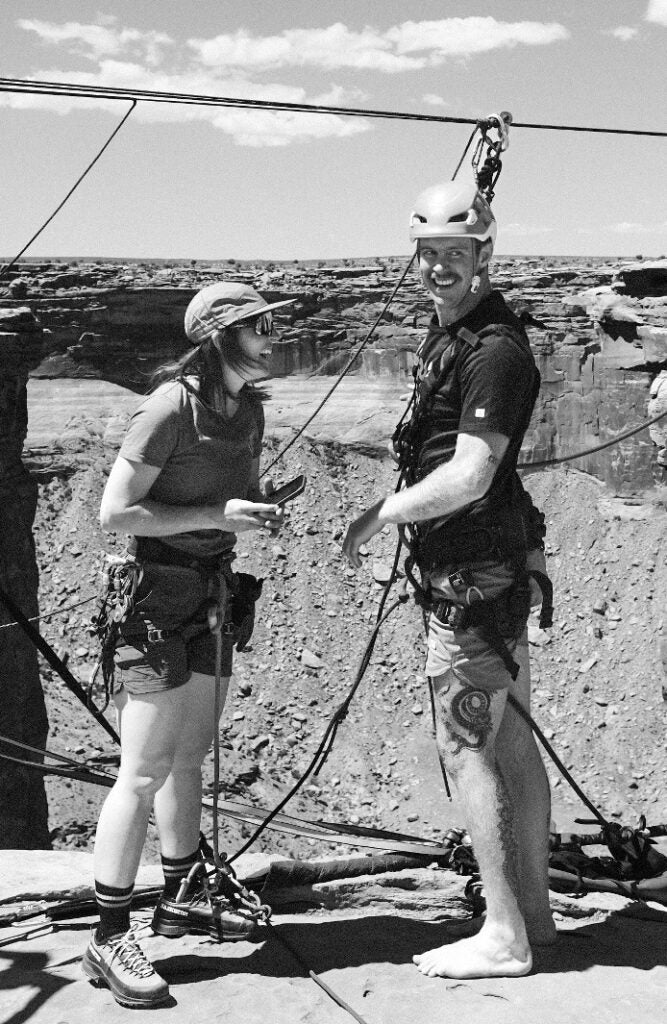
“It required quite a bit of focus,” Greener says of how he managed to do it. “I don’t get adrenaline any more. So it was an immense amount of focus and knowledge of my own body as it pertains to my disability with high-intensity situations that require a lot of coordination.”
Afterward, Greener noticed he had a sharper sense of focus, which is critical for him as an individual walking with a spinal cord injury. “I’m constantly analyzing where my feet are, where the curb is, how many people are moving around me,” he explains. “I’m analyzing every second of how to move through my environment. Highlining allowed me to only focus on that singular moment of one foot in front of the other, and on those tiny individual muscles, despite being paralyzed in some form.”
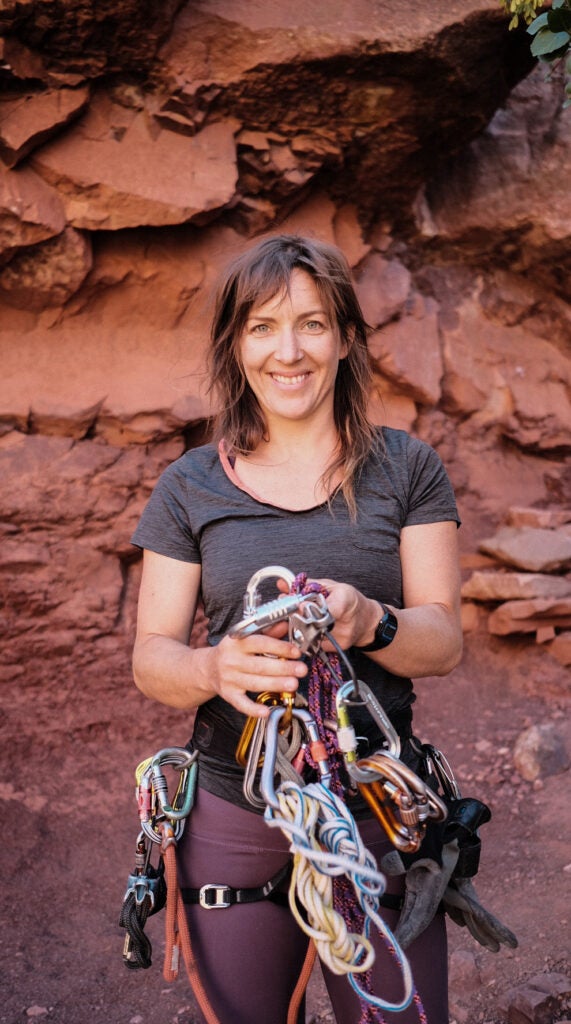
For Dickey, the experience of empowering Greener to highline helped spark her focus on guiding athletes with disabilities. “It was really powerful to see him persevere,” Dickey recalls of the day he made it across the highline.
That’s how her story of making what many consider an “extreme sport” an accessible adventure to almost anyone begins. Of course, it’s not how it ends.
Logistics Above the Void
While highlining might seem far more extreme than its low-to-the-ground sibling of slacklining, it’s arguably safer. Both involve carefully balancing across a line just one to two inch wide. If you fall off a slackline slung between two trees in a backyard or park, you could injure your ankle, for example. But rigged high above the ground, highlining involves falls into the open air. While the exposure fills some with fear, the mechanics of a fall tend to be more favorable.
When Dickey takes people out highlining through her guiding company, Elevate Outdoors, she sets up what she refers to as a top-rope system. This involves a line above the one that the person walks that they can hold on to, aiding balance. If someone does fall, Dickey scurries out onto the line to help them (it can be hard or impossible for a novice to get back up, no matter their physical ability).
One accommodation she’s made for individuals without the use of their legs is that they can scoot along the line on their bottom. Another possibility that she hasn’t yet tried yet is tandem highlining, wherein she’d strap a client to her own body to aid them across. She hasn’t yet guided someone without use of their arms, but she believes tandem guiding or pulling a person across on a rope could potentially work as adaptations.

This past year, Dickey organized a group adaptive highline day. Six people highlined with disabilities including amputated limbs, spinal cord injuries, hyper-mobile joints, and brittle bones disease, also known as osteogenesis imperfecta.
While each person used different adaptations, what struck Dickey is what they all had in common. “Everyone experienced the highline differently with what their body could do on it, but they all had a similar experience mentally, hovering in space 300 feet off the ground on a wobbly line,” Dickey remembers. “There’s an equality in the sense of what we all have to navigate mentally out there. It’s scary for everybody, no matter what their body is doing.”
Another thing Dickey noticed? Guiding a group where everyone has a disability helps people feel more at ease. “As a woman in male-dominated spaces, I know how powerful it is to be a majority,” she observes. She knew what it feels like to be underestimated and to have to fight for a space at the table. “No one was othering each other or treating each other weird or as less capable.”
Yet at the same time, in more remote settings, guiding people with different comfort levels or disabilities can prove a challenge. Recently, Dickey took out two climbers with spinal cord injuries on an ascent of the iconic desert tower: Ancient Art. “It was a huge learning process for me,” she says. One of the climbers struggled on the approach, and the other had a hard time on the route. If two clients aren’t confident that they’ll match each other’s pace and skill on a more technical adventure like this, it might actually be safer—and more fun—for them to split up.
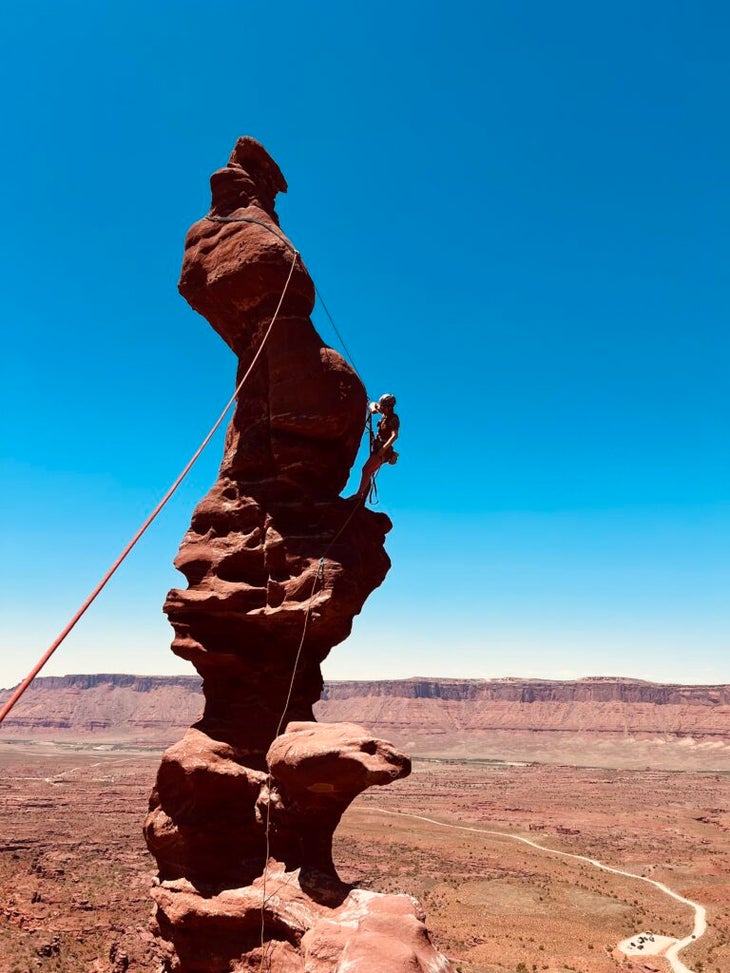
In general, Dickey learns something every time she guides an adaptive adventure. She invites more people with disabilities to reach out so she can become a better provider of accessible adventures through these learning experiences. And with Park City-based National Ability Center becoming more active in Moab, she hopes to gain more experience guiding people from all backgrounds, whether on a sandstone tower or a highline.
But Dickey isn’t the only guide in the adventure town of Moab to make accessibility her mission.
Guiding People “Wherever They Are”
Compared to the rising popularity of pursuits like highlining, experiences like canyoneering, climbing, and kayaking represent the old guard of adventure. One outfitter has been making these experiences more accessible since 2003. “The outdoors should be accessible to everyone,” says Carl Dec, owner of Red River Adventures in Moab. “We’ve always felt like if someone wanted to do these things, it’s what guiding is. Whether you’re able-bodied or have special needs, it shouldn’t matter.”
Red River has more stories of accessible guiding than we could print here. They’ve hosted a 100-person Rocky Mountain Deaf Campers group. Well-maintained boat ramps allow the outfitter to take people in wheelchairs boating, since they can get right to the water’s edge. Dec has taken 20 folks from the Utah School for the Blind canyoneering and climbing. The right-off-the-road accessibility of Moab climbing area Wall Street has enabled him to take people with paralysis rock climbing. While some adventures—like a 3.5-mile canyoneering trip for a person in a wheelchair—present insurmountable challenges, Dec will always find an alternative.
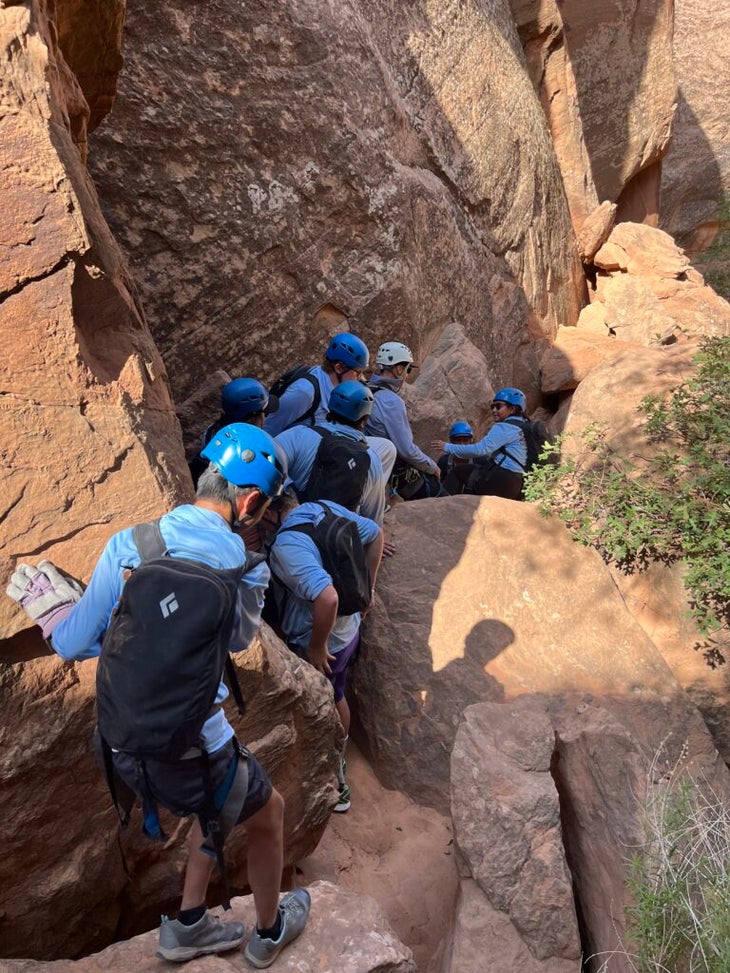
Dec considers adaptive guiding “some of the most rewarding” of his career. Of course, most people become a guide for this very reason—to share their love of an experience that someone can’t do on their own, whether because they lack the ability, skills, or equipment.
Sometimes, it does all come down to the right equipment. That’s why Mike Ballard, owner of Moab-based off-roading outfitter Big Iron Tours, decided to rig a monster five-ton military truck with a wheelchair lift. He bought the used lift off of an old school bus for a few hundred bucks.
The original impetus? Big Iron—whose company motto is “You’ll Scream, You’ll Laugh”—had established relationships with organizations for veterans, many of whom were missing arms or legs. Getting in and out of an off-road vehicle sometimes presented a challenge.
Since, he’s been able to use that truck to take out a 14-year-old quadriplegic girl. An Iraq War veteran with no legs and limited use of his arms. Visually impaired passengers, who travel with companions describing the red rock scenery unfolding around them in vivid detail. And even older folks who struggle with the ladder required to access other trucks.

Now that Ballard has seen how transformational this lift is to the accessibility of off-roading, he’s decided to modify all of his other trucks over time to make them more accessible, whether that’s a sling or crane to help hoist people into seats, or more lifts.
“Every time we get to use the lift, it’s a pain in the ass and a process, but I don’t mind it whatsoever,” Ballard says. “I just feel like I’m blowing people’s minds.”
But the increasingly accessible adventure that’s arguably most life-altering? BASE jumping. As a former tandem skydiving guide, Matt LaJeunesse is no stranger to taking out people with disabilities. He’s skydived with clients with vision impairment, hearing impairment, amputated limbs, and a variety of medical conditions. But in 2022, he decided to switch his focus to BASE jumping and open his own guiding service.
Accessibility continues to be a cornerstone of what LaJeunesse does, now through Tandem BASE Moab. Every year, for example, BASE Moab hosts a retreat for veterans and first responders with PTSD or traumatic brain injuries. LaJeunesse says he’ll never forget the first retreat he hosted. He recalls a lot of hugging and crying among “grown men.”
Sometimes, certain disabilities make a tandem BASE jump impossible. So LaJeunesse carefully evaluates each case, and does whatever he can to make it work. “I can’t promise them a jump,” he says, “but I’ll do everything I can to explore whether morally and ethically it’s a good idea.”

Extreme Equalizers
“Everybody gets shredded their first time,” Dickey says of taking a first-timer out, whether it’s climbing, canyoneering, or highlining—and whether or not they have a disability. “It’s refreshing to realize that the kind of things that happen to someone with a disability are pretty similar to what happens to someone without a disability. You just kind of get a little beat up.”
These adventures involve skills, terrain, and exposure that are unfamiliar to all novices. As a result, they often end up leveling the field. Dec points out that certain adventures or areas that might be inaccessible to someone with a disability are also largely inaccessible to most people. For example, desert towers or the climbing in Indian Creek might remain out of reach for someone in a wheelchair. But he says that these climbing areas would also be too difficult for “a large part of the climbing community.” A case in point Dec offered: Taking a gym climber from Florida up Castleton Tower? Probably not a good idea (no offense, Florida climbers).
Most might think about a disability in the physical sense. But there are many different ways of looking at differences and accessibility through the lens of adventure. Neurodivergence, age, and more factors can all play roles in the experiences we have outside. Dickey, for one, has taken out several kids with autism. “It was a really positive experience to share the outdoors with people who have autism who are experiencing it differently than I am,” she explains.
Whatever someone’s disability or difference, Dickey focuses on treating the person in question like anyone else she might guide. “What I’m hearing from disabled people is they’re often infantilized and treated as if they’re not capable,” she shares. “It kind of traps them in this box.”
Sometimes, a disability can enhance an experience outside. For example, some highliners intentionally blindfold themselves to tune into their balance or make their highline more challenging. “In some ways, I feel like people with vision impairment might have better balance, too,” she speculates.
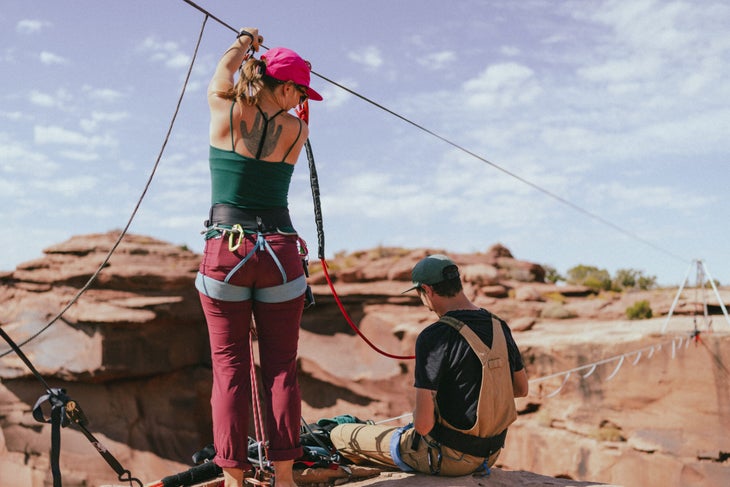
What Adventurous Spirits With Disabilities Should Know
If you have a disability and want to try a new adventure, the guides interviewed for this story have a few recommendations. LaJeunesse admits that he can only take about 50% of the people who reach out to him tandem BASE jumping because of safety concerns.
The most important thing is clear communication. Be upfront about the specific nature of your disability, your needs, your concerns, and your questions. This will help guides create safe and positive experiences, no matter what you’re doing. Follow this advice both before you book and during the guided experience.
Here a few more specific pointers from guides:
- Don’t be afraid to ask for customized experiences. “We can create objectives that suit your needs,” Dickey says.
- Inform the guide clearly about your disability and what support you need. Most guides have their Wilderness First Responder or other backcountry medicine certifications. Still, it can be helpful for them to do research on specific disabilities or carry extra supplies to be as prepared as possible.
- Sometimes, the answer might be “no.” Before accepting any client, LaJeunesse has a personal conversation to assess your physical and mental condition. If access or safety become major concerns, a guide likely will recommend a different experience.
- Not every adventure is ideal for every individual. For example, if you have Parkinson’s or are not in full control of your body, getting near a cliff edge might preclude you from safely BASE jumping. Being too tall or above a certain weight might also mean you’re not a tandem BASE jump candidate. And while Dickey is passionate about creating adaptations for highlining, if you have no use of your arms, choosing another adventure might end up being a more positive experience.
Beyond guides: A Hurdle in Accessible Adventure
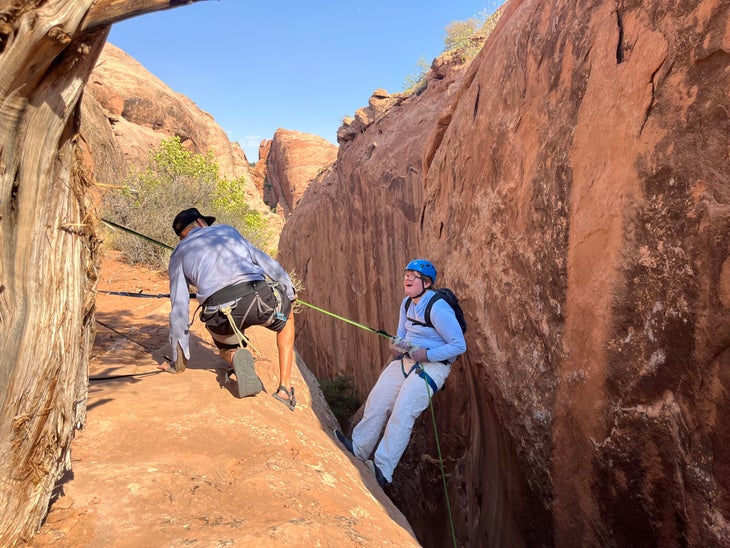
As guides work to make experiences across Southern Utah available to all, the larger recreation community can consider ways to open up the outdoors to more people.
One hurdle that Dickey cites is wheelchair-accessible trails. Fruit Bowl, where she frequently guides highlining, has partially wheelchair-accessible trails. But that’s only true if the person can get out and walk with assistance for short sections. Other areas for highlining or climbing are unreachable if a wheelchair can’t navigate the approach.
“There are some efforts in Moab to make trails more accessible,” Dickey explains. “The BLM is open to it and they’ve hired consultants to help with that.” Though she says that these efforts have been mostly centered on mountain biking. It’s a “way more popular” sport compared to highlining or climbing. Of course, not all trails can be suitable for wheelchairs. However, a few more accessible options would open up additional possibilities for guides.
Where wheelchair-accessible trails are out of the question, LaJeunesse has another idea: a flight in. He has been lobbying the BLM to allow the use of helicopters for people in wheelchairs. Otherwise, these folks often can’t access the cliffs used by BASE jumpers.
As more guides commit to accessibility, demand may grow—and creative solutions like these may follow. Not long ago, the idea of someone with a spinal cord injury ascending a desert tower or a person treating PTSD-induced depression by BASE jumping might have seemed unlikely stories. But the landscape of adaptive adventures is evolving across Moab.
“Just from a disability standpoint, you never imagine that you could highline,” Greener explains. The balance, the logistics, the access—it all seemed super difficult if not impossible to him. But then, in what he calls “that singular moment,” it all came together.
The post Extreme Equalizers: These Moab Guides Are Making Adventure Accessible to People With Disabilities appeared first on Outside Online.










